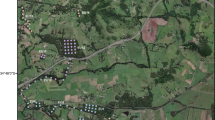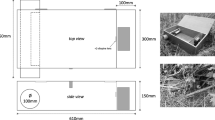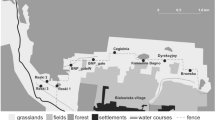Abstract
Monitoring small mustelids like weasels Mustela nivalis and stoats M. erminea is challenging as they are rarely seen, leave scant field signs and display avoidance behaviour towards traps and monitoring devices. The Irish stoat M. erminea hibernica is a subspecies endemic to Ireland and the Isle of Man, and despite being widespread in Ireland, no information exists on its population status due to the difficulty of detection. We compared the efficacy of two camera trap methods to detect Irish stoats in counties Mayo and Galway, Republic of Ireland. Firstly, the ‘Mostela’ (a modified camera trapping device comprising a camera trap and a tracking tunnel inside a wooden box) and secondly, an external camera trap deployed outside the box. We used a single-season occupancy model to estimate the probability of detection and occupancy of Irish stoat using these two methods at 12 sites. Both methods detected stoats, at 17% of sites inside the Mostela and 33% of sites on the external camera, although this non-agreement was not statistically significant. Detection probabilities were low, with wide and largely overlapping confidence intervals for both methods. Occupancy probabilities were relatively low, and the occupancy probability for the external camera was very close to the naïve occupancy estimate. We evaluate the potential applicability of both methods for future work to assess the population and conservation status of this little-studied species.



Similar content being viewed by others

Data availability
The datasets generated during the current study are available from the corresponding author on reasonable request.
Code availability
Not applicable.
References
Breedt B, King CM (2021) Distribution and detectability of mammalian pests in the Waikato Region. New Zealand Journal of Zoology. https://doi.org/10.1080/03014223.2021.1908369
Brown, S. (2001) The behavioural responses of stoats (Mustela erminea) to trapping tunnels. MSc thesis: Lincoln University.
Carter AC, Heinsohn R, Goldizen AW, Biro PA (2012) Boldness, trappability and sampling bias in wild lizards. Anim Behav 83(4):1051–1058. https://doi.org/10.1016/j.anbehav.2012.01.033
Clapperton BK, McLennan JA, Woolhouse AD (1999) Responses of stoats to scent lures in tracking tunnels. New Zealand Journal of Zoology 26(3):175–178. https://doi.org/10.1080/03014223.1999.9518187
Croose, E. & Carter, S.P. (2019) A pilot study of a novel method to monitor weasels (Mustela nivalis) and stoats (M. erminea) in Britain. Mammal Communications. 5: 6–12, London.
Dilks PJ, Lawrence B (2000) The use of poison eggs for the control of stoats. New Zealand Journal of Zoology 27:173–182. https://doi.org/10.1080/03014223.2000.9518223
Elliott G, Willans M, Edmonds H, Crouchley D (2010) Stoat invasion, eradication and re-invasion of islands in Fiordland. New Zealand Journal of Zoology 37(1):1–12. https://doi.org/10.1080/03014221003602166
Garvey PM, Glen AS, Clout MN, Wyse SV, Nichols M, Pech RP (2017) Exploiting interspecific olfactory communication to monitor predators. Ecol Appl 27(2):389–402. https://doi.org/10.1002/eap.1483
Garvey PM, Banks PB, Suraci JP, Bodey TW, Glen AS, Jones CJJ et al (2020) Leveraging personality, motivations, and sensory cues for effective predator management. Trends Ecol Evol 35:990–1000
Glen AS, Cockburn S, Nichols M, Ekanayake J, Warburton B (2013) Optimising camera traps for monitoring small mammals. PLoS ONE 8(6):e67940. https://doi.org/10.1371/journal.pone.0067940
Green SE, Rees JP, Stephens PA, Hill RA, Giordano AJ (2020) Innovations in camera trapping technology and approaches: the integration of citizen science and artificial intelligence. Animals. 10(1):132. https://doi.org/10.3390/ani10010132
Hines, J. E. (2006). PRESENCE- Software to estimate patch occupancy and related parameters. USGS-PWRC. http://www.mbr-pwrc.usgs.gov/software/presence.html.
King CM (1980) Field experiments on the trapping of stoats (Mustela erminea). N Z J Ecol 7:261–266. https://doi.org/10.1080/03014223.1980.10423784
King CM, McMillan CD (1982) Population structure and dispersal of peak-year cohorts of stoats (Mustela erminea) in two New Zealand forests, with special reference to control. N Z J Ecol 5:59–66
King CM, McDonald RM, Martin RD, Tempero GW, Holmes SJ (2007) Long-term automated monitoring of the distribution of small carnivores. Wildl Res 34:140–148. https://doi.org/10.1071/WR05091
King CM, Powell RA (2010) The natural history of weasels and stoats: ecology, behavior, and management, 2nd edn. Oxford University Press, Oxford
Korpela K, Helle P, Henttonen H, Korpimäki E, Koskela E, Ovaskainen O, Pietiäinen H, Sundell J, Valkama J, Huitu O (2014) Predator–vole interactions in northern Europe: the role of small mustelids revised. Proc R Soc B Biol Sci 281:20142119. https://doi.org/10.1098/rspb.2014.2119
Lawrence, B.L. & O’Donnell, C.F.J. (1999) Trap spacing and layout: experiments in stoat control in the Dart Valley, 1992–95. Science for Conservation 118. Department of Conservation, New Zealand.
Lysaght L, & Marnell F (Eds) (2016) Atlas of Mammals in Ireland 2010-2015. National Biodiversity Data Centre, Waterford
MacKenzie DI, Nichols JD, Lachman GB, Droege S, Andrew Royle J, Langtimm CA (2002) Estimating site occupancy rates when detection probabilities are less than one. Ecology 83:2248–2255. https://doi.org/10.1890/0012-9658(2002)083[2248:ESORWD]2.0.CO;2
MacKenzie DI, Nichols JD, Hines JE, Knutson MG, Franklin AB (2003) Estimating site occupancy, colonization, and local extinction when a species is detected imperfectly. Ecology 84:2200–2207. https://doi.org/10.1890/02-3090
MacKenzie DI (2005) What are the issues with presence-absence data for wildlife managers? J Wildl Manag 69(3):849–860. https://doi.org/10.2193/0022-541X(2005)069[0849:WATIWP]2.0.CO;2
Marnell, F., Kingston, N. & Looney, D. (2009) Ireland Red List No. 3: Terrestrial Mammals [pdf]. National Parks and Wildlife Service. Available at: https://www.npws.ie/sites/default/files/publications/pdf/RL3.pdf
McAney, K. (2010) A pilot study to test the use of hair tubes to detect the Irish stoat along hedgerows in County Galway. Report by The Vincent Wildlife Trust.
McDonald R, Harris S (1998) Stoats and weasels. The Mammal Society, London
Merrick J, Koprowski JL (2017) Should we consider individual behavior differences in applied wildlife conservation studies? Biol Cons 209:34–44. https://doi.org/10.1016/j.biocon.2017.01.021
Mos, J. & Hofmeester, T.R. (2020). The Mostela: an adjusted camera trapping device as a promising non-invasive tool to study and monitor small mustelids. Mammal Researchhttps://doi.org/10.1007/s13364-020-00513-y
O’Mahony DT, Powell C, Power J, Hanniffy R, Marnell F, Turner P, O’Reilly C (2017) Non-invasively determined multi-site variation in pine marten Martes martes density, a recovering carnivore in Europe. Eur J Wildl Res 63:48. https://doi.org/10.1007/s10344-017-1108-3
Sleeman, D.P. (1987) The ecology of the Irish stoat. Ph.D Thesis. National University of Ireland.
Sleeman DP (1991) Home ranges of Irish stoats. Irish Naturalist’s Journal 23(12):486–488
Sleeman, D.P. (2016) Irish stoat (Mustela erminea hibernica) pp 101-102. In Lysaght, L. & Marnell, F. (Eds) (2016) Atlas of Mammals in Ireland 2010-2015. National Biodiversity Data Centre, Waterford
Stichting Kleine Marters (2021). Research methods. Available at: https://stichtingkleinemarters.nl/en/research-methods/ [Accessed 25th March 2021]
Tabak MA, Norouzzadeh MS, Wolfson DW, Sweeney SJ, Vercauteren KC, Snow NP et al (2019) Machine learning to classify animal species in camera trap images: applications in ecology. Methods Ecol Evol 10(4):585–590. https://doi.org/10.1111/2041-210X.13120
Weatherbase (2019) Galway: Ireland Available at: https://www.weatherbase.com/weather/weather-summary.php3?s=46930&cityname=Galway%2C+Connaught%2C+Ireland&units=metric [Accessed 25th March 2021]
Acknowledgements
We wish to thank National Parks and Wildlife Service Conservation Ranger John Higgins for his assistance in site selection and for introducing us to landowners. We are grateful to all the landowners for allowing us to access their land. The fieldwork for this study was undertaken as part of a Master’s degree at Queen’s University Belfast. We thank Patrick Wright and three reviewers, whose comments greatly improved the manuscript.
Author information
Authors and Affiliations
Contributions
EC, SPC, RH, KM and JM contributed to the study conception and design. Material preparation was carried out by EC, RH, BH and KM. Data collection was performed by RH and BH. Data analysis was performed by EC and JM. The first draft of the manuscript was written by EC, and all authors commented on the manuscript and approved the final version.
Corresponding author
Ethics declarations
Ethics approval and consent to participate
Not applicable.
Consent for publication
Not applicable.
Competing interests
The authors declare no competing interests.
Additional information
Communicated by Karol Zub.
Publisher's Note
Springer Nature remains neutral with regard to jurisdictional claims in published maps and institutional affiliations.
Rights and permissions
About this article
Cite this article
Croose, E., Hanniffy, R., Hughes, B. et al. Assessing the detectability of the Irish stoat Mustela erminea hibernica using two camera trap-based survey methods. Mamm Res 67, 1–8 (2022). https://doi.org/10.1007/s13364-021-00598-z
Received:
Accepted:
Published:
Issue Date:
DOI: https://doi.org/10.1007/s13364-021-00598-z



